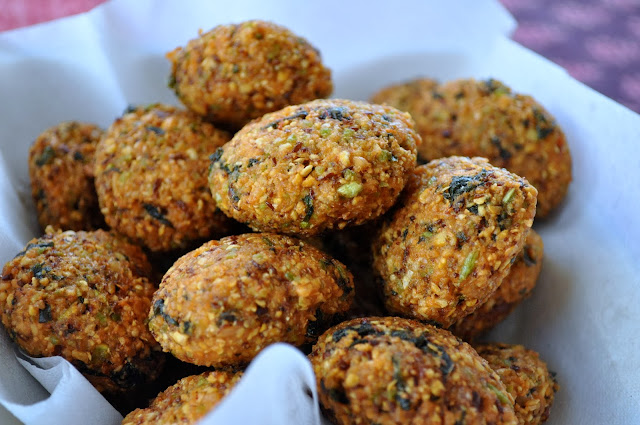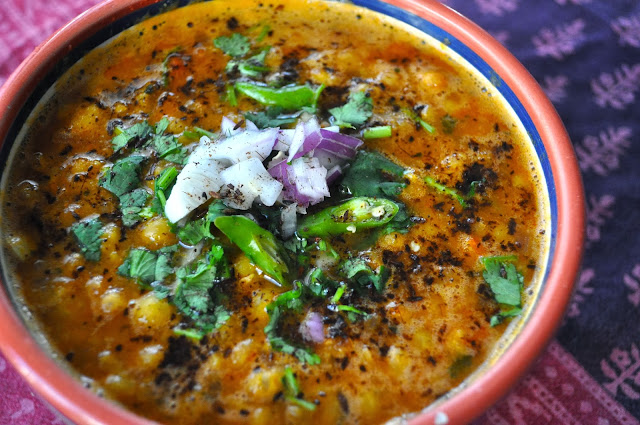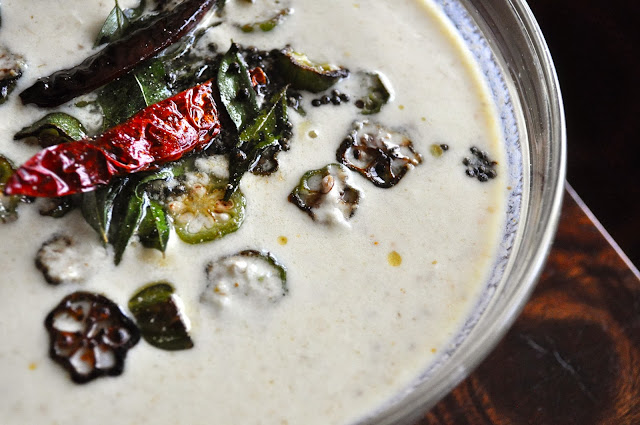On one of our recent trips to India, we stayed for a few
days with our friends in a small town near Mangalore. While we were there, Anand, our host, made molagai podi (some people call it gun powder) with horsegram dal. It gave the molagai podi a great nutty
flavor and I thought I should try it out.
A friend of ours had called us for dinner and asked me to make an appetizer. I had some chopped keerai (amaranth) left over and had been meaning to make keerai vadai for the longest time. I just soaked my usual dals as if I were making masala vadai, but added the sprouted horsegram dal also while making the batter and mixed in the amaranth leaves.
I have never used horsegram dal before. In Tamil, it is called kollu (kulith in
hindi – I think), and is typically used in cattle feed.
I bought horsegram dal and do use it to make molagai podi
here now. The thing with buying
groceries here in the U.S. though, is that you can’t buy in small quantities. I had to buy a 2 lbs. bag of horsegram
dal even though I only needed a little for the molagaipodi. So I had to try and figure out other
ways to use up the rest of the dal.
Since it looks very similar to moth, and I have successfully
sprouted moth to make usal, I decided to sprout horsegram dal too. It sprouted really well.
A friend of ours had called us for dinner and asked me to make an appetizer. I had some chopped keerai (amaranth) left over and had been meaning to make keerai vadai for the longest time. I just soaked my usual dals as if I were making masala vadai, but added the sprouted horsegram dal also while making the batter and mixed in the amaranth leaves.
Note: I learned
the hard way that horsegram dal has stones that need to be picked out. Sorry Sanjay, Swati and anyone else who
got “lucky”. Please clean the dal
before soaking.
Here is what you need:
(makes about 50 vadas)
- ½ cup horsegram dal (please pick out the stones!!!!)
- ½ cup channa dal
- ½ cup toor dal
- ½ cup green split peas
- a small handful urad dal
- a small handful moong dal
- 4 – 6 green chilies
- 4 red chilies
- 1” piece ginger
- ½ tsp. hing
- 1 – 2 cloves garlic
- salt to taste
- 1 cup amaranth leaves, washed and chopped
- ½ medium red onion, chopped
- 1 sprig curry leaves
- oil for deep frying
Here is how I made it:
- Soak the horse gram dal overnight. Drain the water, place the dal in a bowl and cover with a wet cloth or paper towel. Let it sprout for a couple of days.
- Soak all the other lentils together for a couple of hours.
- Drain the water out and grind these along with the sprouted horsegram dal, green chilies, red chilies, ginger, garlic, hing, and salt, to a coarse paste, adding little or no water.
- Add the chopped amaranth leaves, onions, and curry leaves. Mix well.
- Heat oil for deep frying in a deep pan or kadai.
- Make lime size balls of the batter, flatten it slightly and gently drop it into the oil. You can fry 5 -6 vadas simultaneously.
- Fry the vadas on medium-low heat, turning them over occasionally, till they are golden brown on both sides.
- Repeat till all the batter is done.
Serve hot with chutney of your choice.
























